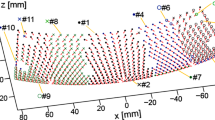Abstract
Laser adjustment is a new technique that employs laser forming processes to align components along specific directions. To develop a laser adjustment solution with a minimal number of bends, herein, a new modeling and calculation method that uses robotic kinematic theories is introduced. A numerical example and the corresponding laser adjustment solution are presented. The simulation results suggest that a straight tube with a flange connector can be adjusted to match the corresponding connector with three bends. Finally, the simulation results were verified using experiments. The maximum deviation was approximately 0.4 mm and the deviation of the flange connector was smaller, showing that a good adjustment quality could be achieved using the specific adjustment solution.










Similar content being viewed by others
References
Shen H (2008) Mechanism of laser micro-adjustment. J Phys D Appl Phys 41(24):245106
Qi L, Namba Y (2011) Precision laser adjustment using CW diode laser. Precis Eng 35(1):126–132
Shen H, Gong C, Hu J et al (2012) Numerical and experimental study on bi-direction deformations in laser micro forming of two-bridge actuators. Int J Mach Tools Manuf 54:66–72
Hennige T, Holzer S, Vollertsen F et al (1997) On the working accuracy of laser bending. J Mater Process Technol 71(3):422–432
Folkersma G, Brouwer D, Römer GW (2016) Microtube laser forming for precision component alignment. J Manuf Sci Eng 138(8):081012
Folkersma KGP, Römer G, Brouwer DM et al (2016) High precision optical fiber alignment using tube laser bending. Int J Adv Manuf Technol 86(1–4):953–961
Li W, Yao YL (2001) Laser bending of tubes: mechanism, analysis, and prediction. J Manuf Sci Eng 123(4):674–681
Hao N, Li L (2003) An analytical model for laser tube bending. Appl Surf Sci 208:432–436
Folkersma KGP, Brouwer DM, Römer GRBE et al (2016) Robust precision alignment algorithm for micro tube laser forming. Precis Eng 46:301–308
Siciliano B, Khatib O (2016) Springer handbook of robotics. Springer, Berlin
Raghavan M, Roth B (1993) Inverse kinematics of the general 6R manipulator and related linkages. J Mech Des 115(3):502–508
Denavit J, Hartenberg RS (1955) A kinematic notation for lower-pair mechanisms based on matrices. Trans ASME J Appl Mech 22:215–221
Qiao Y, Chen Y, Yang J et al (2017) A five-axis geometric errors calibration model based on the common perpendicular line (CPL) transformation using the product of exponentials (POE) formula. Int J Mach Tools Manuf 118–119:49–60
Sun T, Yang SF, Huang T et al (2018) A generalized and analytical method to solve inverse kinematics of serial and parallel mechanisms using finite screw theory. Computational kinematics. Springer, Cham, pp 602–608
Chen G, Wang H, Lin Z (2014) Determination of the identifiable parameters in robot calibration based on the POE formula. IEEE Trans Robot 30(5):1066–1077
Wei Y, Jian S, He S et al (2014) General approach for inverse kinematics of nR robots. Mech Mach Theory 75:97–106
Dai JS (2012) Finite displacement screw operators with embedded Chasles’ motion. J Mech Robot 4(4):041002
Besl PJ, Mckay ND (1992) A method for registration of 3-D shapes. IEEE Computer Society, Washington
Acknowledgements
This work was supported by the National Natural Science Foundation of China (Grant Nos. 51121063, 51575354, 51105255, 51205251), the National Key Technology Research and Development of the Ministry of Science and Technology of China (Grant No. 2014CB046604), and by the Shanghai Municipal Science and Technology Project (Grant Nos. 15111102203, 15111107902).
Author information
Authors and Affiliations
Corresponding author
Rights and permissions
About this article
Cite this article
Li, P., Xi, JT. Modeling of laser adjustment for large diameter tubes using robotic kinematic theories. Adv. Manuf. 6, 401–408 (2018). https://doi.org/10.1007/s40436-018-0235-8
Received:
Accepted:
Published:
Issue Date:
DOI: https://doi.org/10.1007/s40436-018-0235-8



